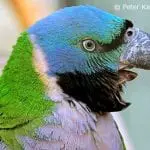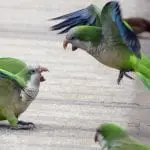Scientific Facts
| Crimson Name | Golden-Winged Parakeet |
| Scientific Name | Brotogeris chrysoptera |
| Life Span | 10+ years |
| Size | Medium |
| Habitat | Tropical or subtropical forests |
| Country of Origin | Amazon basin |
Physical Description
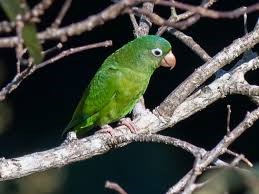
The golden-winged parakeet is a species of parrots that belong in the family Psittacidae. It is a medium-sized bird that has feathers in varying shades of green. The head has a brighter green crown that continues to the back of the head. The wings are also in a similar shade of green, but the neck is more of yellow-green. The tail is short but is mostly darker green The beak, legs, and claws have the same fleshy color. There is a white circle around the dark brown to black eyes.
You might describe the golden-winged parrot as looking very common and very typical of parrots, but once you find out how intelligent this bird is, you’ll admire it all the more. This bird’s behavior range from quiet to very rowdy. It can mimic whistles, sounds, but sadly, this may not mimic human words.
Subspecies
According to experts, there are five known subspecies. These are currently recognized and differ in their wings and tail color and patterns. These subspecies also differ in the color of the frontal part of the head and the spot on the chin.
Golden-Winged Parakeet status
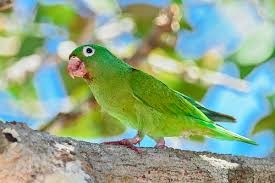
The golden-winged parakeet is a parrot species of least concern by the IUCN. However, the population of this bird can diminish in number because of natural and human threats in the Amazon basin. Recently, fires struck different parts of the Amazon, which were said to be due to deforestation, commercialization, and farmers reclaiming land to plant on. These practices will affect the life and the future of the golden-winged parakeet and other animals that call the rainforest their home.
Lifespan
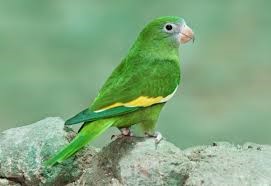
Experts say that the golden-winged parakeet can live up to 10 years or more in captivity; however, there is no information regarding the lifespan of this parrot in the wild. It is also thought that the reasons why this parrot lives longer in captivity are the care they get from their owners and immediate expert medical attention for their medical conditions.
Natural Habitat
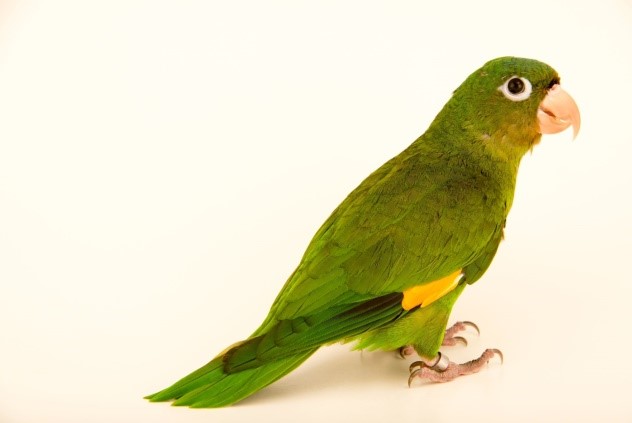
The golden-winged parakeet is naturally found in South American countries like Brazil, Guyana, French Guyana, Suriname, and Venezuela. It ranges from the eastern parts of the Amazon Basin and along the lower Orinoco River of eastern Venezuela. It lives in habitats like subtropical and tropical areas that are moist and heavily-degraded forests.
Perception and Communication
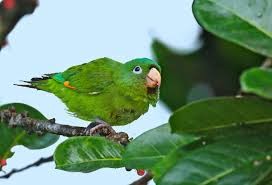
The golden-winged parakeet is a noisy bird, especially when it is foraging with their friends and family members. These birds may remain in an area to feed, socialize, and to breed, and usually, these go off in pairs during the breeding season.
It is capable of mimicking music, whistles, and noises but may lack the ability to follow the words and sounds of humans. If you want to teach this parrot some tunes, remain with it for a while to repeat the sound over and over again. It won’t take too much time to learn to whistle and to mimic noises.
Behavior
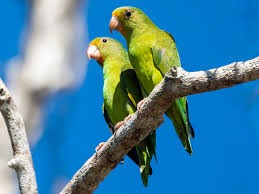
The golden-winged parakeet is a very intelligent bird as it can learn how to follow some sounds and whistles. It can also be petted and handled, which can be done in just a short time. This parrot will love to be the center of attention as it performs tricks for you.
Another good quality of this parrot is that it breeds with a lifetime partner. It will rear its young and reunite with the flock after it’s done, preparing them for an independent life.
Development and Breeding
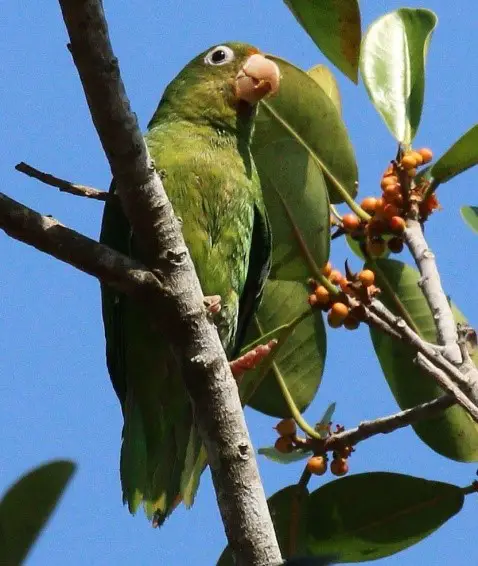
There is very little information about the golden-winged parakeet development and breeding. What is known is that this bird will prepare a nest high up in a tree and keep it warm by lining it with tree parts. There is an elaborate ritual before mating, which is common in most parrot species. The female will lay around 2 to 5 eggs in the nest and will refuse to leave her nest to protect her offspring. The baby birds swill fledge after a few weeks, and only when these birds have shed all their downy feathers.
Food and Diet
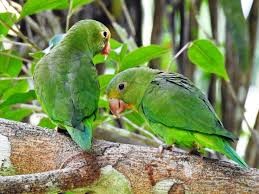
Golden-Winged Parakeets are herbivores with their natural diet composed of seeds, fruits, nuts, nectar, berries, and other green food. Common plants that these birds love to eat are members of the Asteraceae, Myrtaceae, and Rosaceae.
The Golden-Winged Parakeet is not good as seed or pollen spreaders because these will crush the seeds before they eat them. There is also a parakeet that lives in areas where humans are located that eat grains and seeds from farms and gardens. This behavior makes them pests to farmers and gardeners.
Aside from plants, Golden-winged Parakeets may also eat insects and insect larvae. These will eat termites, caterpillars, weevils, beetles, moths, etc.
In captivity, the Golden-Winged Parakeet may eat high-quality, commercially-prepared seed mixes with sunflower, oats, safflower, millets, and hemp seeds. You may also feed your pet some fresh fruits, dried berries, vegetables, pine nuts, and jams.
Captive parakeets will also require mineral supplements during the breeding season. The most important nutrient is calcium, which is needed for bone and egg health. Also, parents need soft food as they raise their chicks.
You may also feed parakeet hemp seeds. These seeds have complete amino-acids, omega 3 and 6 fatty acids and micronutrients to help your pet grow healthy and strong. Hemp seeds also contain high amounts of protein, which is important for good health.
Captive Environment and Housing
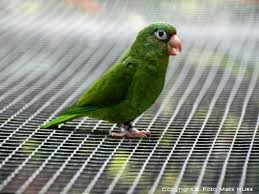
Golden-Winged Parakeets need a large cage. A very large cage is a good idea if you decide to keep more parrots for the company. A spacious cage made of metal with a secure door is a must. Keep this door locked and secure to prevent your pets from escaping and prevent predators from entering.
This bird needs sturdy branches where it can sit and perch. Use live plants as places where they can stay or sleep. Use cage furniture for your pet to play in. Use ropes, perching blocks, wooden or DIY birdhouses, a medium-sized bowl for bathing, mirrors, swings, and so many more.
Leave a water basin and a container for food. The container should have a bigger mouth so that the bird can easily eat from it. Use two or more food containers if you have several birds. You can place the cage on top of a sturdy surface such as a table, or you can use a cage with a stand. The area must not be under direct sunlight and should be free moist areas which can often cause molds.
The cage must have efficient bedding to absorb urine and smells. Coconut husks or wood shavings are perfect bedding materials. You may also line the cage with old newspapers, paper towels, or brown paper.
When cleaning the cage, place your pets in another cage. Hose it down to remove dirt and grime. Retrieve food and water containers; clean these separately using a cleaning solution.
Use only cleaning products with disinfectant properties to work with remove tough dirt and smell. You may install natural plants inside the cage, but you need to care for these separately. Regularly remove felled or dead stems and leaves. Water the plants daily and take these out from the cage to have some sun as well.
Health and Common Issues
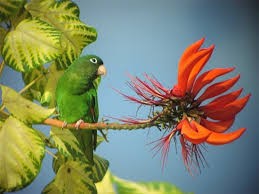
The Golden-Winged Parakeet is a healthy and hardy parakeet but is not immune to some illnesses that plague birds.
Bird fever or psittacosis in birds
Bird fever is a common infectious disease that affects most species of birds. This disease is spread through contact with the droppings of infected birds. Symptoms are restlessness, watery and green droppings, discharge coming from the eyes and nose, lack of appetite, and lack of energy.
Bird fever should be treated ASAP because it is contagious to humans. If you suspect bird fever in your pets, wear proper protective equipment when feeding them or cleaning their cages.
Malnutrition
Your pet can also suffer from malnutrition, which is usually due to an imbalanced diet or have diets with insufficient nutrients. Any of these illnesses included in this list may also contribute to malnutrition. Symptoms are feather stress bars and dark feather colors.
You can prevent malnutrition by making sure that your bird is getting enough sunlight, especially in caged specimens. If you cannot move, the birdcage uses artificial lighting. Also, be very careful in changing the bird’s diet. Usually, captive birds will refuse to eat the new food and may starve themselves until you change their food. When this happens, take your pet to an avian vet and seek help on how to improve its diet.
Giardia in birds
Giardia is a parasitic infection passed from one infected bird to another through cysts, which are in the bird’s droppings. The most common cause of giardia is unclean water supply. Giardia symptoms include diarrhea, weight loss, dry and itchy skin, and constipation. If you suspect this condition, take your bird to the vet as soon as possible. Giardia may be passed to humans if the community or home’s water supply is the same as the contaminated water supply of birds.
Pacheco’s disease in birds
Pacheco’s disease is a viral disease due to a kind of herpes virus. The sick bird may spread this disease through contact with infected droppings and nasal discharge. Also, the herpes virus may be dormant in a bird and activated when it is in stress. Therefore, you should avoid stressing your pet.
Some situations that are stressful to birds are the death of a mate, moving homes or residences, and breeding. Symptoms of Pacheco’s disease include tremors, sinusitis, lack of energy, and anorexia, green-colored droppings, and may even result in death if the symptoms are overlooked. You can prevent the spread of Pacheco’s disease by placing sick or suspected birds on quarantine. This disease can be fatal to birds, but it cannot be transferred to humans.
Avian polyomavirus in birds
Avian polyomavirus is an infectious disease that can affect mammal and birds. This is a deadly disease that is common in young birds. This may also be passed on to other birds through droppings and contact with infected birds.
Symptoms of avian polyomavirus are a huge abdomen, lack of appetite, vomiting, diarrhea, and dehydration. If the disease is not treated, your pet can lose weight and die of complications. To avoid this, have your pet vaccinated against avian polyomavirus. Remember that this disease may be passed on to humans, so you must have your pet checked ASAP.
Aside from these conditions, you must monitor your Golden-Winged Parakeet for any of the following symptoms, such as strange appearance, plucking of feathers, trembling, walking in circles, hanging their beak, poor balance, changes in behavior or attitude and other unique changes. Any change in the bird’s eating, droppings, breathing, feathers, legs, and feet must be consulted to a vet as soon as possible.
Preventive Care
Just like all parrot pets, the Golden-Winged Parakeet must undergo a complete physical examination every 6 to 12 months. Take your pet to an avian veterinarian and not just an ordinary vet. If you have any concerns about the health of your bird and any questions about his diet, care, and training, consult an avian vet.
Your pet must be submitted for annual fecal examination for yeast, parasites, and bacteria infestation. Your pet will be receiving vaccination for polyomavirus and other illnesses and routine blood testing to make sure that there are no worries about his health.
Also, captive Golden-Winged Parakeets must-have nail and wing trimming at least once a year. Take it to an avian vet to get these done properly and carefully.
And to avoid illness, clean your bird’s cage weekly. Remove droppings and wash the cage using a safe cleaning product. Always clean the feeding and drinking dishes as well as all its toys and furniture to prevent the spread of illnesses and various health conditions.
Availability – Where to Get One
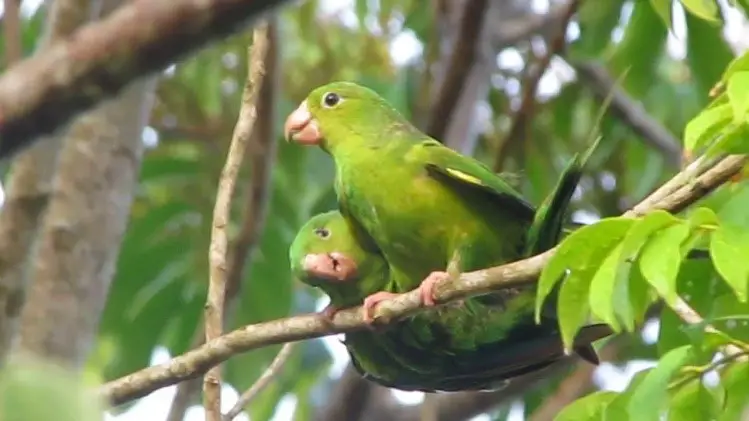
Golden-Winged Parakeets may be purchased from a breeder, or an avian pet store locally or online. The price for a Golden-Winged Parakeet online is from $100 to $200 depending on the gender, age, and appearance of the bird. This is a common parrot species, but still, buying birds online can cost more since you’ll be paying for shipment and delivery fees.
Instead of buying a Golden-Winged Parakeet and other exotic birds from a breeder, you may consider adopting birds from bird adoption groups or rescue organizations. These institutions are in search of new and loving families to welcome abandoned or rescued birds in their homes.
How to Care for a Golden-Winged Parakeet
Golden-Winged Parakeets are intelligent and resilient parrot breeds and may have similar needs as with other parrots but may also have unique care requirements. Providing daily care, nutrition, and training, plus medical attention is a must. You must also be willing to commit to daily cage maintenance. Never give up on training your pet because this will help maintain your pet’s proper mental and physical condition.
Choose a large cage that’s spacious, comfortable, and safe. As a rule, the cage should be big enough to allow your bird to spread his wings without touching the bars. When taking care of two or more birds, use a large cage or a custom-made cage. Place live trees or plants to serve as perches and bird toys.
Hold your pet regularly. This will create a close bond between you and your pet, which will help you teach it new tricks. Learn how to hold it and gain its trust before you start playing it on your shoulders. Despite its size, protect yourself from this bird’s sharp claws. Use a glove to protect your hands.
Feeding should also be monitored. Give it appropriate bird food. You can use commercially-prepared food which is ready to use and is available in most pet shops and suppliers. For fruits and vegetables, buy only organic produce only. Have a fixed feeding schedule, and don’t feed too much to avoid obesity and other health illnesses. Always place a bowl with clean water inside the cage and keep the water fresh by replacing it daily.
Use cuttlebone or any cage furniture to allow your pet to sharpen its beak. A cuttlebone contains calcium, and thus your pet can ingest this mineral as it sharpens its beak. Your avian vet can also help cut the nails and feathers of your pet using special grooming tools.
FAQs
Can you train your golden-winged parakeet to perform tricks?
Yes, you can teach a golden-winged parakeet to perform tricks, but you need to establish trust first. You can do this by daily handling, giving treats, and offering pats and lots of attention.
How do you feed a new golden-winged parakeet?
Place a large, heavy bowl in the middle of the cage and place food inside the bowl. For commercially-made bird food, just place this in the bowl; for fruits, vegetables, and nuts, cut these into appropriate sizes.
How do you take the golden-winged parakeet out of its cage?
It may take time for a golden-winged parakeet to trust you, so initially offer treats, food, and a lot of praises. It has to hop from the cage to your hand and not fly away, so you must establish trust first before it can be safely removed from the cage.
Will a golden-winged parakeet be afraid of other pet animals in your home?
At first, yes, it can become afraid of other pets at home, but once you handle it daily, interact with it daily, and it will not just be comfortable with your presence but also its life at home.
Can a golden-winged parakeet live with other parrots of its kind?
Yes, you can house a golden-winged parakeet with other golden-winged parakeets. Just make sure that you have a lot of space in your cage or use a custom-made cage to house your pets.
Can golden-winged parakeets live with other parrot species?
Yes, a golden-winged parakeet is very social, and it can even socialize with other parrot species.
Will your golden-winged parakeet eat it is young?
There are some reports that parrots can eat their young, and it is still unknown as to why they do this. If you see that your female golden-winged parakeet is eating her young, remove it from the nest, and this should not be allowed to breed.
Will a golden-winged parakeet bite?
Yes, it may bite your hand or your finger if you are not careful, especially if it has not been tamed.
Will a golden-winged parakeet learn how to talk?
Sadly, the golden-winged parakeet cannot talk or learn human words. It may only whistle and mimic some noise but will not talk.
How do you pet a golden-winged parakeet?
You have to gain this bird’s trust first. Start by offering treats whenever you hold it or pet it; it will soon understand that it will get treats if you pet it or handle it. Be consistent so your pet will trust you more.
Is a golden-winged parakeet a good first-time pet bird?
Yes, it can be a good first-time pet bird or pet parrot because of its outgoing nature and intelligence. But you need to commit to regular training and handling so your pet will understand that it can trust you.
Do you feed golden-winged parakeet insects?
A golden-winged parakeet does not eat insects or insect larvae. It will only feed on plant parts, including fruits, nuts, and seeds. In captivity, this bird can eat commercially-prepared food such as assorted nuts, fruits, vegetables cut into very small pieces.
Does a golden-winged parakeet recognize its owner?
Yes, the golden-winged parakeet is very intelligent and can recognize its owner as well as other people responsible for its care.

